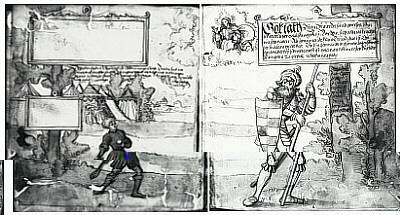
Anonymous, Goliath, c1500
"Goliath" is another obscure fechtbuch recently "uncovered" and resurrected by Grzegorz Zabinski (in association with the Brotherhood of the Eagle's Nest, Poland - no longer active) from the archives of the Uniwersytet Jagiellonski, Poland, originally part of the collection of "Die Preussische Koenigliche Staatsbibliothek" in Berlin,is thought to have been written sometime c1500. The reasoning behind the approximate year is based on the analysis of the garments worn by the individuals in the illustrations.
 |
| Found in the opening of the manuscript, what appears to be a depiction of David and Goliath |
The first frame contains text that includes "Burckharit - Schönauer". It is not known who these represent...perhaps the previous owners of the manuscript, who "sold" the manuscript to the National Library Berlin. The name "Burckharit" is a very common name in Switzerland.
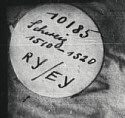 |
| A mark or stamp which may indicate when the Berlin Library actually received the manuscript |
In the history of the National Library Berlin, there is an indication that in 1886, the department of handwritten medieval manuscripts first opened, and this Goliath manuscript was "sold" or donated to the library by Ls.Burckhardt-Schönauer at its opening. Therefore, it would strongly suggest that the date in the stamp may be October 1885. Also, the mark "Schweiz 1510-1520" may indicate that the manuscript was indeed, written in Switzerland between the years 1510 and 1520. This evidence suggests that one of the members of the "Burckhardt" may have written this manuscript during that period. However, on plate 568, there is the following inscription in the "address" which indicates "Aus der Erbschaft Burckhardt-Bachofer (Bachofen?)" which means "From the Legacy of Buckhardt-Bachofer". This may be another branch of the same family, as it is not uncommon in Switzerland to have double names.
 This German manuscript contains beautifully detailed illustrations of a pair of fighters, in full plate harness, depicting various types of engagements, including longsword, jousting and mounted combat. Other illustrations depict individuals in unarmoured dress working the dagger and unarmed techniques.
This German manuscript contains beautifully detailed illustrations of a pair of fighters, in full plate harness, depicting various types of engagements, including longsword, jousting and mounted combat. Other illustrations depict individuals in unarmoured dress working the dagger and unarmed techniques.
The fechtbuch is comprised of a total of over 568 pages including front and back cover, and includes many blank pages and other pages that seem to have been "work in progress". It is also interesting to note that there must have been at least three (3) different writers contributing to this fechtbuch, based on the very different writing styles.
A translation of the longsword chapter is available and is based on Grzegorz Zabinsky's transcript. It was translated by of AEMMA. Click on the shield on the left to view the work online.
About the presentation: The manuscript is presented as image files (jpg) which include the original text. Click on the small images on the left below to retrieve a larger image for closer examination. Click here for details on registering with AEMMA and obtaining your Online Library electronic card.
 |
1.0 Plates 3,5,6: David & Goliath There is no translated text available for this manuscript at this time. However, there is enough material in this fechtbuch that would make for another very interesting translation and study project (the other being "Gladiatoria"). The first part of the fechtbuch contains three images in which the last pair of images of the intro depicts what appears to be David and Goliath. David with a rock in his hand and sling (plate 5) and Goliath depicted as a rather large individual, wearing heater-like shield, some armour, longsword sheathed and helm. Click on the image on the left to sequentially go through the images in this section, or click on the few plate numbers at the end of each section as alternative jump points into their respective section to review an enlargement. |
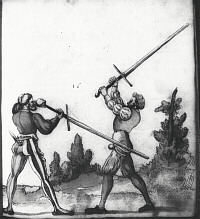 |
2.0 Plates 08 - 177: Longsword This section of the fechtbuch focuses on Longsword techniques. The manuscript has a high volume of text in all areas, including the longsword section. The individuals are in civilian garments. In order to facilitate your navigating through the manuscript, those plates that contain illustrations are included in the jump points following. Manuscript Backgrounder: On plate 8, there is a stamp near the bottom of the page that includes the words "Staatsbibliothek Berlin" which is the National Library Berlin. The stamp apparently was in use between approximately 1900 and 1930 (dates are unconfirmed). Note: Some pages do not appear in the sequence given that they are blank pages of the original manuscript. Here are some other jumping off points within section 2 tageting illustrations: plates 29, 32, 38, 39, , 43, 45, 48, 50, 52, 54, 56, 58, 62, 64, 67, 69, 73, 76, 78,80, |
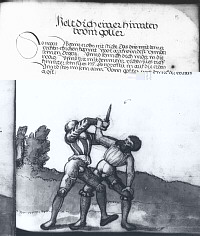 |
3.0 Plates 183 - 200: Dagger The dagger appears consistent with the earlier Talhoffer treatises, in that the dagger shares similar attributes to the rondel daggers in the earlier treatises. The techniques shown are again, fairly consistent with Talhoffer's earlier works as well as some of the techniques depicted in Fiori dei Liberi's manuscript. |
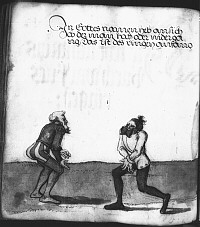 |
4.0 Plates 201 - 331: Grappling At this time, it is unclear what the text covers between 201 and 227, and therefore, to get to the first illustration of grappling, go to slide 228. It is also interesting to note that the text in this manuscript appears to come from three (3) different writers, due to their distinctive writing styles across the manuscript. Within this section, there must have been at least two different writers, yet the illustrations all share similar attributes implying a single artist had created them. Another interesting note is plate 291, whereby there appears to be a sketch of a hand leading out of the text to the left margin. |
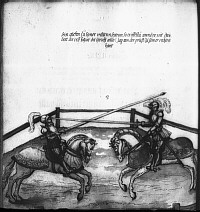 |
5.0 Plates 332 - 448: Jousting & Mounted Combat A fascinating collection of illustrations depicting both armoured and unarmoured techniques on horseback. These techniques include jousting with the typical lance, engagement on horseback while fighting with swords, and also takedown. The following notes describe some of the more interesting illustrations: 351 - armoured, 2-hander fighting on horseback, - sword fighting, lances on the ground, unarmoured, leg armour resting on the ground, 405-406 are part of the same illustration, in which the individual on the left is not mounted, positions the end of the lance into the earth and pointing the tip towards the oncoming rider, in armour on horseback, meanwhile, he has his lance extended horizontally, missing the guy on the ground. Similarily with 409 & 410. Another interesting note is plate 291, whereby there appears to be a sketch of a hand leading out of the text to the left margin. |
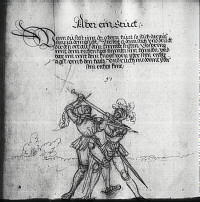 |
6.0 Plates 449 - 450: Armoured Half-sword A notable aspect of these illustrations is that they are incomplete. They appear as sketches prior to the final touches required to complete the illustrations. |
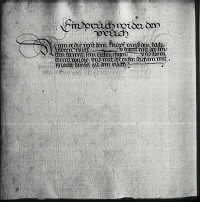 |
7.0 Plates 451 - 568: Text The tail-end of the manuscript is comprised of written text. Many of the pages appear not completed. The very last page at 568 appears to represent the total number of pages per section of this manuscript or an draft of the index. |